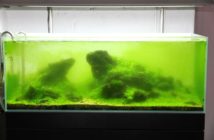
Mixed Reef Aquarium
Ever since people started bringing the ocean into their living rooms, sand has played a major part of the aquarium setup. In the early days of aquarium keeping, the substrate of choice was gravel, crushed shells/coral, and playground sand. These types persisted for several years, but eventually gave way to more realistic sand types. Obviously we want our tanks to mimic nature, so it was inevitable that more natural-looking sand would find its way into our aquariums. But aesthetics aren’t the only benefit. Natural sand is typically finer than previously utilized sands, opening up a doorway to sand sifting organisms like gobies, sea stars, and cucumbers which would all starve in tanks with larger grain sand. Additionally, aragonite-based sand has tremendous benefits in that is has the ability to buffer tank pH and aids in calcium/alkalinity stability. Despite which sand you choose, every option plays a huge role in biological filtration.

Aragonite Sandbed in Home Aquarium
In order to fully explain the role sand plays in filtration, I must first discuss the nitrogen cycle. Whenever you first start an aquarium, you typically begin with some form of sand and live rock. The sand is usually dead (dried out) and the rock is uncured. And by uncured, I’m referring to the fact that there is a lot of dead or dying organisms on the rocks. After you place the sand and rock into the tank, ammonia will skyrocket. Bacteria present in the aquarium will begin to consume ammonia and convert it to nitrite. Nitrite then spikes, allowing a different population of bacteria will grow and process nitrite into nitrate…which is harmless. Nitrates themselves can be further processed and converted into nitrogen gas. But what is sand’s role in all this? For one, sand provides a huge surface area on which the bacteria live. The bacteria live on the sand and live rock within the tank and are continually breaking down excess nutrients into harmless forms. Smaller grain sand provides a greater amount of surface area than larger sizes, so it is the most useful in a filtration sense. But it goes further than that.

Aragonite Sandbed in Mixed Reef Aquarium
In deep sand beds, there exists an anoxic, or oxygen poor, area. This layer can easily be seen from the front and sides of the aquarium where the sand meets the glass (or acrylic), and is home to anaerobic bacteria that convert nitrates into nitrogen gas. The gas can bubble out of the aquarium, thereby keeping your nitrates low and making deep sand beds very attractive as a form of filtration. But they have their drawbacks.
Obviously deep sand beds are just that, deep. They will dramatically decrease the vertical room you have in the aquarium and will displace a lot of water thereby reducing your overall gallons of water drastically. Secondly, powerheads can blow sand all over the place. If you have a lot of flow, sand will relocate and occasionally bury corals and rocks. An often overlooked drawback is cost. Most sand can run $1-$3 per pound, so you could imagine a sand bed 5 or 6″ deep in a large tank could easily run several hundred dollars. Lastly, and most importantly, deep sand beds have been known to crash, killing everything in the tank. The main reason for this

Tiger Tail Sea Cucumber
occurring is due to the accumulation of harmful nutrients deep within the sand bed. Hydrogen sulfide is among them, and if released can wreak havoc on an aquarium. To get around this, many suggest replacing the sand bed periodically.
If you don’t want a deep sand bed, you have other options. Some people run shallow sand bed aquariums and other run no sand at all. The last of which pretty much warrants its own article. But shallow sand beds work similarly to deep sand beds in that they provide some surface area for bacteria. Obviously though, they do not provide much of an anoxic area for nitrate processing.

Bare Bottom SPS Dominated Aquarium courtesy of Chris (aka crvz)
All-in-all, sand beds provide tremendous benefits to the average aquarist. They serve as a huge source of filtration, provide feeding grounds for many fish and invertebrates, buffer tank pH, and they make the setup look more natural.
Permissions and Sources:
Chris (aka crvz)…personal information withheld per request
Other images provided by the author






Pingback: Barebottom Aquarium Setups, a Sandless Approach | AquaNerd()